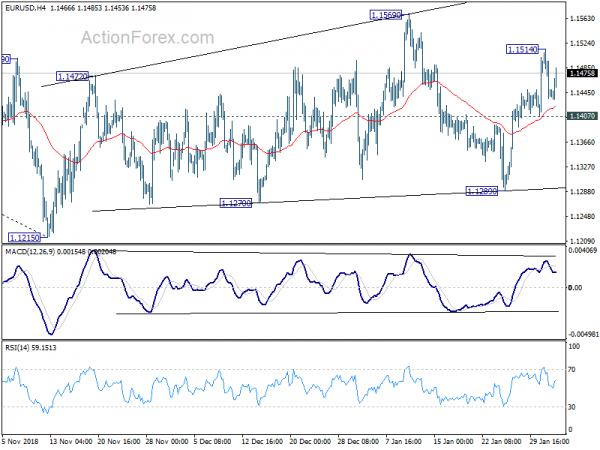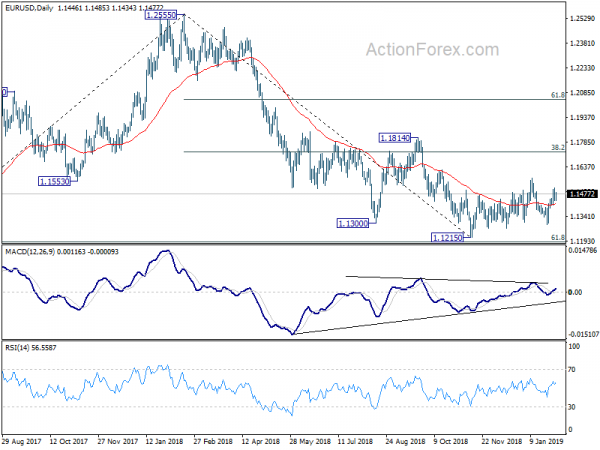Dollar is back under some pressure in early despite very strong headline NFP number. The problem with the report is that, other parts are rather weak, including revision in prior month’s figure, rise in unemployment rate. More importantly, wage growth is a clear miss. The greenback is extending recent decline against Canadian. And it would probably do so against Euro and Australian too.
For now, in the currency markets, New Zealand Dollar is the strongest one for today, followed by Euro. Sterling is the weakest one, followed by Yen and then Dollar. For the week. Pound is the worst performing one, followed by Dollar and then Swiss Franc. Commodity currencies are all the strongest.
In other markets, DOW future point to slightly higher open. FTSE is up 0.41%, DAX is up 0.07%, CAC is up 0.16%. German 10-year yield is down -0.001 at 0.152. Earlier in Asia, Nikkei rose 0.07%, Hong Kong HSI dropped -0.04%, China Shanghai SSE rose 1.30%, Singapore Strait Times dropped -0.05%. Japan 10-year JGB yield dropped -0.0226 to -0.019.
NFP grew 304k… but wage growth missed, unemployment rate rose
US non-farm payroll grew 304k in January, well above expectation of 165k. However, prior month’s figure was revised sharply down from 312k to 222k. Unemployment rate rose to 4.0% versus expectation of 3.8%. But labor force participation rate also rose to 63.2%, up from 63.1%. Wage growth is a clear miss with average hourly earnings rose 0.1% mom versus expectation of 0.3% mom.
Eurozone PMI manufacturing finalized at 50.5, adds to likelihood of recession
Eurozone PMI manufacturing was finalized at 50.5 in January, unrevised, down from December’s 51.4. It’s the six consecutive months of decline and the lowest level since November 2014. Markit noted that “output up marginally, but sharpest fall in new work recorded since April 2013”. Also, “growth sustained via reduction in backlogs and fastest accumulation of stocks in survey history”.
Among the countries, Italy PMI manufacturing hit 47.8, a 68-month low. Germany reading was also in contraction at 49.7, a 50-month low. Franc reading recovered mildly to 3-month high of 51.2. But Ireland reading hit 27-month low, Austria reading hit 29-month low and the Netherlands reading hit 28-month low.
Chris Williamson, Chief Business Economist at IHS Markit said, “the January PMI adds to the likelihood that the manufacturing sector is in recession and will act as a drag on the economy in the first quarter.” “There appears to be a more deep-rooted malaise setting in, which reflects widespread concerns about the destabilising effect of political uncertainty and the damage to exports from rising trade protectionism.”
Eurozone CPI slowed to 1.4%, but core edged up to 1.1%
Eurozone CPI slowed to 1.4% yoy in January, down from 1.6% yoy, matched expectation. Core CPI, rose to 1.1% yoy, up from 1.0% yoy and beat expectation of 1.0% yoy. Looking at the main components of euro area inflation, energy is expected to have the highest annual rate in January (2.6%), followed by food, alcohol & tobacco (1.8%), services (1.6%) and non-energy industrial goods (0.3%).
From Swiss, PMI manufacturing dropped to 54.3 in January, down from 57.8, missed expectation of 56.6. SECO consumer confidence improved to -4, up from -6. Retail sales dropped -0.3% yoy in December versus expectation of 0.4% yoy.
UK PMI manufacturing dropped to 52.8, stocks up on Brexit preparations
UK PMI manufacturing dropped to 52.8 in January, down from 54.2 and missed expectation of 53.5. That’s also a 3-month low. Markit noted that “stocks of purchases rise at survey-record rate”. And, “employment falls for only the second time in past 30 months”.
Rob Dobson, Director at IHS Markit,. said “Stocks of inputs increased at the sharpest pace in the 27-year history, as buying activity was stepped up to mitigate against potential supply-chain disruptions in coming months. There were also signs that inventories of finished goods were being bolstered to ensure warehouses are well stocked to meet ongoing contractual obligations.”
And, “based on its historical relationship against official data, the January survey is consistent with a further solid contraction of production volumes, meaning manufacturing will likely act as a drag on the economy in the first quarter.”
China Caixin PMI manufacturing dropped to 48.3, no significant effect from countercyclical economic policy
China Caixin PMI manufacturing dropped to 48.3 in January, down from 49.7 and missed expectation of 49.7. That’s the lowest reading since February 2016 and points to continued softening in the health of China’s manufacturing sector. Markit also noted that underlying trend in production weakens. Export sales increase slightly, but overall new work softens. Though, a positive note is that business confidence rose to eight-month high.
Zhengsheng Zhong, Director of Macroeconomic Analysis at CEBM Group said “On the whole, countercyclical economic policy hasn’t had a significant effect. While domestic manufacturing demand shrank, external demand turned positive and became a bright spot amid positive progress in Sino-U.S. trade talks. As companies were more willing to reduce their inventories, their output declined, indicating notable downward pressure on China’s economy. China is likely to launch more fiscal and monetary measures and speed up their implementation. Yet the stance of stabilizing leverage and strict regulation hasn’t changed, which means the weakening trend of China’s economy will continue.”
Japan PMI manufacturing finalized at 29-month low, bad news for global trade cycle
Japan PMI manufacturing was finalized at 50.3 in January, revised up from 50.0. But that’s still the lowest level in 29 months. And, new export orders decline at sharpest pace since July 2016. Also, business confidence falls for the eighth month running.
Joe Hayes, Economist at IHS Markit said “the data “brought bad news for the global trade cycle at the start of 2019, with new export orders falling at the sharpest rate in two-and-a-half years” And, “domestic markets also showed signs of frailty as total demand declined for the first time since September 2016.”
Besides, “with Abe set to levy the consumption tax this year, and Sino-US trade tensions still lurking, domestic weakness in Japan further adds to already existing challenges.
Also from Japan, jobless rate dropped to 2.4% in December, below expectation of 2.5%.
EUR/USD Mid-Day Outlook
Daily Pivots: (S1) 1.1417; (P) 1.1466; (R1) 1.1496; More…..
Intraday bias in EUR/USD remains neutral at this point. With 1.1407 minor support intact, further rise is in favor. Rise from 1.1289 is seen as another rising leg in the correction pattern from 1.1215. Above 1.1514 will target 1.1569 resistance and above. On the downside, break of 1.1407 minor support will turn bias back to the downside for 1.1289 support instead.
In the bigger picture, as long as 1.1814 resistance holds, down trend down trend from 1.2555 medium term top is still in progress and should target 61.8% retracement of 1.0339 (2017 low) to 1.2555 at 1.1186 next. Sustained break there will pave the way to retest 1.0339. However, break of 1.1814 will confirm completion of such down trend and turn medium term outlook bullish.
Economic Indicators Update
| GMT | Ccy | Events | Actual | Forecast | Previous | Revised |
|---|---|---|---|---|---|---|
| 21:30 | AUD | AiG Performance of Manufacturing Index Jan | 52.5 | 49.5 | 50 | |
| 23:30 | JPY | Jobless Rate Dec | 2.40% | 2.50% | 2.50% | |
| 00:30 | AUD | PPI Q/Q Q4 | 0.50% | 0.60% | 0.80% | |
| 00:30 | AUD | PPI Y/Y Q4 | 2.00% | 2.10% | ||
| 00:30 | JPY | PMI Manufacturing Jan F | 50.3 | 50 | 50 | |
| 01:45 | CNY | Caixin PMI Manufacturing Jan | 48.3 | 49.7 | 49.7 | |
| 06:45 | CHF | SECO Consumer Confidence Jan | -4 | -5 | -6 | |
| 07:30 | CHF | Retail Sales Real Y/Y Dec | -0.30% | 0.40% | -0.50% | -0.60% |
| 08:30 | CHF | PMI Manufacturing Jan | 54.3 | 56.6 | 57.8 | |
| 08:45 | EUR | Italy Manufacturing PMI Jan | 47.8 | 49 | 49.2 | |
| 08:50 | EUR | France Manufacturing PMI Jan F | 51.2 | 51.2 | 51.2 | |
| 08:55 | EUR | Germany Manufacturing PMI Jan F | 49.7 | 49.9 | 49.9 | |
| 09:00 | EUR | Eurozone Manufacturing PMI Jan F | 50.5 | 50.5 | 50.5 | |
| 09:30 | GBP | PMI Manufacturing Jan | 52.8 | 53.5 | 54.2 | |
| 10:00 | EUR | Eurozone CPI Core Y/Y Jan A | 1.10% | 1.00% | 1.00% | |
| 10:00 | EUR | Eurozone CPI Estimate Y/Y Jan | 1.40% | 1.40% | 1.60% | |
| 13:30 | USD | Change in Non-farm Payrolls Jan | 304K | 165K | 312K | 222K |
| 13:30 | USD | Unemployment Rate Jan | 4.00% | 3.80% | 3.90% | |
| 13:30 | USD | Average Hourly Earnings M/M Jan | 0.10% | 0.30% | 0.40% | |
| 14:30 | CAD | Manufacturing PMI Jan | 53.6 | |||
| 14:45 | USD | Manufacturing PMI Jan F | 54.9 | 54.9 | ||
| 15:00 | USD | ISM Manufacturing Jan | 54.3 | 54.1 | ||
| 15:00 | USD | ISM Prices Paid Jan | 58 | 54.9 | ||
| 15:00 | USD | ISM Employment Jan | 56.2 | |||
| 15:00 | USD | Construction Spending M/M Dec | ||||
| 15:00 | USD | U. of Mich. Sentiment Jan F | 90.7 | 90.7 |














